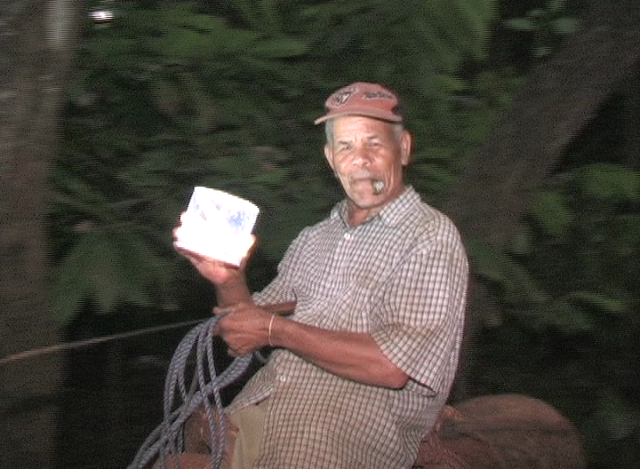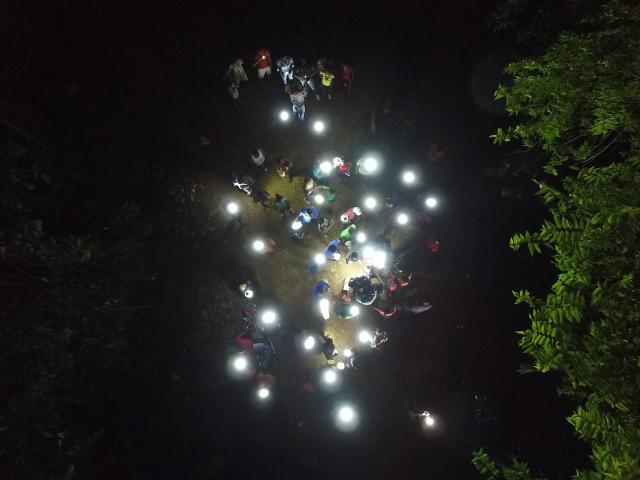Outside of glitzy resort areas like Punta Cana, many Dominicans (about 8 million) live in the dark during nightly electric blackouts. An additional 1 to 1.5 million are off the electric grid. In a country with an estimated population of about 10.4 million, it’s a crisis that affects almost everyone.
While tourists enjoy the nightlife, most of the locals cough on smoke or fumes from candles and kerosene lanterns. But for about $5 per person, a new campaign aims to let there be light in Dominican homes all night long via an inflatable, solar-charging LED lamp. It is one of many lighting efforts around the world—requiring a complex dance with donors, nonprofits, governments, and for-profit companies.
“I grew up over there, so I have firsthand experience what it’s like to live without light,” says Jacqueline Gallardo, a real estate exec now living in the U.S. “I know what it is to do homework with a candle.” Gallardo was on a flight to visit family back home in 2013 when she sat next to Shawn Hakim, an MBA student at UCLA who had just read an article about solar-charging LED lanterns from companies like D.Light and Mpowerd.

The travelers started brainstorming a solar-light venture called Esenciales; they also started a romantic relationship. Gallardo and Hakim, now head of business development at Rayton Solar, began with their own money, purchasing more than 400 lanterns to light up El Choco, a village in a national park of the same name. Environmental preservation has limited the town’s connections to the outside world, and kept it off the grid.
Gallardo and Hakim now aim much bigger with the Dominican Light Project—attempting to raise up to $26 million to provide every poor family with a solar lantern called Luci, made by Mpowerd. They are starting with an Indiegogo campaign. “Every project is ambitious,” says Mpowerd cofounder John Salzinger. “They always start with these unbelievable numbers, and they always end up at a fraction of that.” Hakim says that he doesn’t expect to crowdfund anywhere near $26 million; $25,000 would help the people most in need.
Lighting Up Economic Development
Gallardo and Hakim want the Dominican Light Project be more than a heartwarming story. “It’s not charity,” says Hakim. They are attempting a very grassroots economic development program, and have piles of stats to back it up. Based on surveys in El Choco, they found that Luci allows children to study almost twice as long per day, and that grades have gone up. The portable lamps also help kids on their way to school, and to their jobs. The journey begins and ends each day with a 10-mile walk in the dark between the village and the nearest bus stop—illuminated at best with a flaming piece of moldy bread that’s been dipped in kerosene.
Extra light allows parents to work longer too, says Gallardo, and saves a lot of money. Based on a survey that Esenciales conducted, families spend the equivalent of about 55 cents per day on candles or kerosene—first-world pocket change that can run as high as 27% of total income in dirt-poor villages. Then there are dramatic health benefits: Inhaling fumes from a kerosene lamp all night is about as bad as smoking two packs of cigarettes.
Raising even $26 million won’t end the darkness. Lamps are free to charge with the plentiful sunlight, but the batteries wear out in 2 to 5 years, says Esenciales. (Mpowerd says that they can last for up to 10 years.) “I’m hoping that in five years…that the technology has caught up with it, and they have a couple of different systems like solar panels and other things like that,” says Gallardo. Such programs are in the works, for example, from Mpowerd. “Next year we expect to get into a more robust, micro-grid model,” says Salzinger, cryptically, as he’s not ready to reveal details. In the meantime, says Hakim, “our lanterns are an extremely inexpensive way to bring light to the…Dominican people for integrals of five years until something does happen.”

“A lot will have to do with the government and how much they integrate with the program,” says Salzinger. Esenciales has asked the Dominican government for funding. “Nobody said yes, nobody said no,” says Hakim. They also pursued microlending organizations like ADEMI, ADOPEM, and Esperanza; but they don’t lend such small amounts of money as the lanterns cost. “With governmental or large NGO (nonprofit) organizations, you’re a little bit at their mercy,” says Salzinger. “You’re basically moving a tank. You’re not moving a little boat.”
The Business Of Foreign Aid
Lamp makers like Mpowerd and D.Light are B Corporations, a growing category of companies that commit to providing public benefits. But they also have to make money for shareholders. April was the first profitable month for Mpowerd, which started in 2012, which has sold more than 1.6 million lamps to 105 countries.
Mpowerd makes the bulk of its money in places like the U.S., Europe, and Japan, selling Lucis for activities like camping. “In terms of the developing world or emerging market, we try to stay away from the morality side,” says Salzinger. “Everything should be aligned with a business case.” Mpowerd’s site, and much of the media coverage, features the benefits Luci brings to poor communities, but they are not pro-bono efforts. Mpowerd sells its products to NGOs (226 of them so far). It has donated lamps to the Nepal earthquake recovery, but Salzinger calls that something any decent company would do. In addition, customers can buy the budget Luci EMRG model at the full $9.95 price, which the company sends to charity efforts (recently the Nepal relief).
The higher-end Luci Original model headed to the Dominican Republic lists for $14.95, though Esenciales has negotiated a volume discount that Hakim won’t disclose. The $25 total cost includes items like fees to Indiegogo, credit card transaction fees, and transportation. (Esenciales reckons the $5-per-person cost based on the average Dominican family size.)
A major part of the cost is customs fees: up to 65% of what officials judge a product to be worth, says Gallardo. And they may judge products to be worth a higher price than they actually cost. The government of the Dominican Republic is making money from a charity effort to aid its citizens. The government can exempt charities from import fees. “It’s really, really hard to get on those lists,” says Hakim.
A Light In A Dark World
No matter how successful the Dominican Light Project may be, it’s just one piece of a complex global problem. Estimates peg the number of people in the world who are off the grid at up to 1.5 billion; and many others can’t afford electricity or are subject to daily blackouts. “There’s a huge amount of people that are affected by energy poverty,” says Salzinger. “We think it’s probably closer to a third of the world.”
Contrast those scenarios with a country like the United States, where a frequent complaint is that abundant electric lighting makes it hard to see the stars at night. “It’s almost unimaginable to imagine the American life without light,” says Hakim. “It’s a human need. It’s something that people must have.”
UPDATED: This article has been updated to correct the number of Luci lamps sold and to include Mpowerd’s battery-life estimate.
Fast Company , Read Full Story
(28)